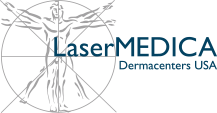What is Microdermabrasion?
Microdermabrasion is a procedure that uses fine aluminum oxide crystals and a controlled vacuum to exfoliate the skin. After the treatment, the skin has improved texture and softness, as well as fewer imperfections such as wrinkles and acne scars.
How does the treatment work?
The skin is washed to remove excess oil and dirt. Then, a medical professional targets a stream of aluminum oxide crystals over the area. The crystals abrade away old, dead skin cells, which the vacuum then picks up with gentle suction. This promotes the growth of collagen and new, rejuvenated skin. Moisturizers and sun block are then applied to the treated
area.
How many treatments are required?
Microdermabrasion works best when repeated over several weeks. Typically a series of 5 to 6 treatments allows for the optimal result. However, all patients are different therefore, discuss the optimum schedule and number of treatments with your medical professional.
Is Microdermabrasion safe?
Microdermabrasion is a safe and common procedure. But, as always, provide your full medical history and follow your post-treatment instructions.
Are there any possible side effects?
You may experience some redness and discomfort similar to a sunburn after the treatment. Skin conditions may appear worse for a short time, and your skin may become temporarily lighter or darker.
Will there be any downtime?
One of the advantages of Microdermabrasion is that it has no downtime. You can return to your normal routine and apply cosmetics directly after treatment. LaserMedica Pro Defend SPF 30 and Mineral cosmetics are highly recommended.
What are the results?
The skin feels softer and appears younger. Minor wrinkles are eventually improved by the growth of new collagen. Exfoliation improves small brown spots, uneven skin tone, acne and acne scars.
How soon will results appear?
A difference is noticeable immediately, and results improve with multiple treatments. Skin improvement varies depending on your individual skin quality.
How long does a Microdermabrasion treatment last?
A Microdermabrasion facial treatment lasts about half an hour. Additional time is required for additional areas.
What conditions respond best to this treatment?
Microdermabrasion works well for damaged skin, whether affected by acne, sun damage or aging.
Who are candidates for Microdermabrasion?
Microdermabrasion can be used to rejuvenate skin of any type. Those seeking to reduce minor flaws or wrinkles without downtime are encouraged to consider Microdermabrasion.
Who should avoid Microdermabrasion?
Microdermabrasion should be avoided by those with recent viral infections, such as cold sores and shingles, those with eczema, sunburns or rosacea, those with auto-immune disorders, poor healing or excessive scarring and those with a history of diabetes or keloid formation. You must not have recently had laser surgery or used Accutane.
How does the treatment feel?
Microdermabrasion does not require anesthesia, although it may be mildly uncomfortable. Tightness and heat are common effects and quickly fade.
How long do the results last?
Lasting effects are dependent on proper skin care. Additional treatments will renew your youthful appearance. A series of six treatments over a few months is recommended for best results, followed by regular maintenance treatments.
What are the limitations of Microdermabrasion?
Microdermabrasion is designed for minor imperfections and general improvement. Those with very large or dark spots, moderate to deep wrinkles and serious scars should seek an alternative treatment.
Instructions for before treatment:
Avoid Retin-A®, sun tanning or tanning creams for at least a week before treatment. Do not have other facial procedures, such as chemical peels over 30 concentration, before treatment.
Instructions for after treatment:
Sun block and moisturizers should be applied after treatment. Anti-inflammatory creams or cold compresses may be used as necessary. Avoid irritating the treated skin with harsh chemicals, rubbing or sun tanning for one week. Contact your doctor immediately in the event of any rare effects such as blistering, scabbing or infection.
